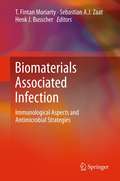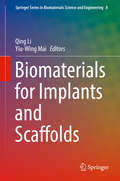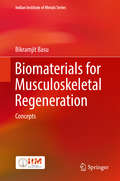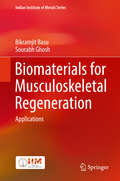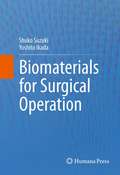- Table View
- List View
Biomaterials and Nanotechnology for Tissue Engineering
by Swaminathan Sethuraman Uma Maheswari Krishnan Anuradha SubramanianNanotechnology and high-end characterization techniques have highlighted the importance of the material choice for the success of tissue engineering. A paradigm shift has been seen from conventional passive materials as scaffolds to smart multi-functional materials that can mimic the complex intracellular milieu more effectively. This book presents a detailed overview of the rationale involved in the choice of materials for regeneration of different tissues and the future directions in this fascinating area of materials science with specific chapters on regulatory challenges & ethics; tissue engineered medical products.
Biomaterials and Nanotechnology for Tissue Engineering
by Swaminathan Sethuraman, Uma Maheswari Krishnan and Anuradha SubramanianNanotechnology and high-end characterization techniques have highlighted the importance of the material choice for the success of tissue engineering. A paradigm shift has been seen from conventional passive materials as scaffolds to smart multi-functional materials that can mimic the complex intracellular milieu more effectively. This book presents a detailed overview of the rationale involved in the choice of materials for regeneration of different tissues and the future directions in this fascinating area of materials science with specific chapters on regulatory challenges & ethics; tissue engineered medical products.
Biomaterials and Their Applications (SpringerBriefs in Materials)
by Hamid Reza Rezaie Leila Bakhtiari Andreas ÖchsnerThis short book presents an overview of different types of biomaterial such as bio ceramics, bio polymers, metals and bio composites, while especially focusing on nano biomaterials and their applications in different tissues. It provides a compact introduction to nano materials for drug delivery systems, tissue engineering and implants, while also reviewing essential trends in the biomaterial field over the last few decades and the latest developments.
Biomaterials and Tissue Engineering (Stem Cell Biology and Regenerative Medicine #74)
by Oguzhan Gunduz Christophe Egles Román A. Pérez Denisa Ficai Cem Bulent UstundagThis contributed volume covers all fundamental principles for researchers and professionals interested in the field of Biomaterials and Tissue Engineering, an interdisciplinary field of research with contributions from biomedical scientists, engineers, and physicians. With a strong focus on biomaterials and scaffolds, the book also covers testing and evaluation pathways for in vitro and in vivo studies. This book also presents a broad range of topics including fundamentals of 3D printing and bioprinting, followed by contemporary technology used in tissue engineering applications as well as currently available biomaterials suitable for tissue repair and regeneration. This volume provides information on: (i) why humans need biomaterials, especially in medical applications, (ii) different types of tissue engineering strategies, and (iii) modeling, characterization, and evaluation of outputs of those strategies. This book is a reference material in the field of tissue engineering, and it is very useful for bachelor, M.Sc., and Ph.D. students, researchers, academics, medical, industry, and healthcare professionals from diverse backgrounds.
Biomaterials and Tissue Engineering (Biological and Medical Physics, Biomedical Engineering)
by Donglu ShiThe current interest in developing novel materials has motivated an increasing need for biological and medical studies in a variety of dinical applications. Indeed, it is dear that to achieve the requisite mechanical, chemical and biomedical properties, especially for new bioactive materials, it is necessary to develop novel synthesis routes. The tremendous success of materials science in developing new biomaterials and fostering technological innovation arises from its focus on interdisciplinary research and collaboration between materials and medical sciences. Materials scientists seek to relate one natural phenomenon to the basic structures of the materials and to recognize the causes and effects of the phenomena. In this way, they have developed explanations for the changing of the properties, the reactions of the materials to the environment, the interface behaviors between the artificial materials and human tissue, the time effects on the materials, and many other natural occurrences. By the same means, medical scientists have also studied the biological and medical effects of these materials, and generated the knowledge needed to produce useful medical devices. The concept of biomaterials is one of the most important ideas ever generated by the application of materials science to the medical field. In traditional materials research, interest focuses primarilyon the synthesis , structure, and mechanical properties of materials commonly used for structural purposes in industry, for instance in mechanical parts of machinery.
Biomaterials as Stem Cell Niche (Studies in Mechanobiology, Tissue Engineering and Biomaterials #2)
by Krishnendu RoyRecent developments in stem cell biology have opened new directions in cell therapy. This book provides the state-of-the-art developments in using biomaterials as artificial niches for engineering stem cells, both for the purpose of better understanding their biology under 3D biomimetic conditions as well as for developing new strategies for efficient long term maintenance and directed differentiation of stem cells into various therapeutic lineages. Animal and human stem cells of both embryonic and adult origin are discussed with applications ranging from nerve regeneration, orthopedics, cardiovascular therapy, blood cell generation and cancer therapy. Both synthetic and natural biomaterials are reviewed with emphasis on how material-stem cell interactions direct specific signaling pathways and ultimately modulate the cell fate. This book is valuable for biomaterial scientists, tissue engineers, clinicians as well as stem cell biologists involved in basic research and applications of adult and embryonic stem cells.
Biomaterials Associated Infection: Immunological Aspects and Antimicrobial Strategies
by T. Fintan Moriarty, Sebastian A.J. Zaat and Henk J. BusscherBiomaterials associated infection (BAI) is one of the most common complications associated with implantation of any biomaterial regardless of form or function. These infections usually involve bacterial colonization and biofilm formation on the biomaterial itself, rendering the infection impervious to antimicrobials and host defenses. In addition, it is becoming increasingly clear that infection of the surrounding tissues also plays an important role in BAI, and that the infection may be influenced by the composition and design of the implanted biomaterial. In this book, worldwide leaders in the field address this critical problem in the translation of biomaterials research into clinical practice. The book begins with an emphasis on the latest research in the pathogenesis of BAI from microbiological, immunological, and materials science perspectives. The current state of the art in antimicrobial activation of biomaterials through surface modification and the incorporation of antimicrobial agents is then discussed. In the concluding chapters, successful translation of a selection of antimicrobial technologies from preclinical research into clinical use is described alongside a discussion of the utility of these devices and perspectives for future development. This book is essential reading for researchers and clinicians who are interested in understanding the fundamentals of BAI, the latest in antimicrobial materials research, and the state of the art in clinically available antimicrobial containing medical devices.
Biomaterials Effect on the Bone Microenvironment: Fabrication, Regeneration, and Clinical Applications
by Yingying Jing Xiao Chen Jiacan SuBiomaterials Effect on the Bone Microenvironment Practical resource on clinical bone regeneration from a variety of related interdisciplinary researchers Biomaterials Effect on the Bone Microenvironment focuses on the structure-activity relationship between bone biomaterials and microenvironment regulation, presenting a systematic exposition from all aspects of biomaterials regulated microenvironment in bone regeneration and covering design strategies, applications, and mechanisms of biomaterials that regulate bone microenvironment, along with the methods for manufacturing biomaterials and their clinical translation. The subject’s potential challenges and future development direction are discussed, and the design and initiative principle of tailored biomaterials with various features, including bioactive components and physicochemical property, are elucidated in depth. Numerous biomaterials, including natural and synthetic, are summarized and compared. Their advantages and features are also evaluated, particularly in bone microenvironmental regulation and bone generation. Moreover, the stimulation mechanism of the microenvironment to bone generation is discussed in detail, including mechanical-support effect, redox effect, pro-angiogenesis effect, inflammatory immune effect, and anti-aging effect. Biomaterials Effect on the Bone Microenvironment provides further coverage of sample topics such as: Role of bone microenvironment and its associated biomaterials in modulation bone diseases, reviewing the biomaterials used to regulate bone microenvironment Relationship between biological factors of various materials and physiological functions in bone microenvironment Application of the third generation of biomaterials, which would regenerate the bone to regulate bone microenvironment Emerging biological material manufacturing technology and mechanisms of novel biomaterial modulating microenvironment for bone regeneration Future outlook of bone tissue engineering along with the general process of bone remodeling and regeneration With comprehensive coverage of one of the most promising and valuable candidates for clinical bone regeneration, Biomaterials Effect on the Bone Microenvironment is an ideal resource for materials scientists, biotechnologists, biochemists, bioengineers, orthopedists, and clinical chemists who want to stay on the cutting edge of this rapidly evolving field.
Biomaterials Effect on the Bone Microenvironment: Fabrication, Regeneration, and Clinical Applications
by Jiacan Su Xiao Chen Yingying JingBiomaterials Effect on the Bone Microenvironment Practical resource on clinical bone regeneration from a variety of related interdisciplinary researchers Biomaterials Effect on the Bone Microenvironment focuses on the structure-activity relationship between bone biomaterials and microenvironment regulation, presenting a systematic exposition from all aspects of biomaterials regulated microenvironment in bone regeneration and covering design strategies, applications, and mechanisms of biomaterials that regulate bone microenvironment, along with the methods for manufacturing biomaterials and their clinical translation. The subject’s potential challenges and future development direction are discussed, and the design and initiative principle of tailored biomaterials with various features, including bioactive components and physicochemical property, are elucidated in depth. Numerous biomaterials, including natural and synthetic, are summarized and compared. Their advantages and features are also evaluated, particularly in bone microenvironmental regulation and bone generation. Moreover, the stimulation mechanism of the microenvironment to bone generation is discussed in detail, including mechanical-support effect, redox effect, pro-angiogenesis effect, inflammatory immune effect, and anti-aging effect. Biomaterials Effect on the Bone Microenvironment provides further coverage of sample topics such as: Role of bone microenvironment and its associated biomaterials in modulation bone diseases, reviewing the biomaterials used to regulate bone microenvironment Relationship between biological factors of various materials and physiological functions in bone microenvironment Application of the third generation of biomaterials, which would regenerate the bone to regulate bone microenvironment Emerging biological material manufacturing technology and mechanisms of novel biomaterial modulating microenvironment for bone regeneration Future outlook of bone tissue engineering along with the general process of bone remodeling and regeneration With comprehensive coverage of one of the most promising and valuable candidates for clinical bone regeneration, Biomaterials Effect on the Bone Microenvironment is an ideal resource for materials scientists, biotechnologists, biochemists, bioengineers, orthopedists, and clinical chemists who want to stay on the cutting edge of this rapidly evolving field.
Biomaterials Engineering and Devices: Volume 1: Fundamentals and Vascular and Carrier Applications
by Donald L. Wise Debra J. Trantolo Kai-Uwe Lewandrowski Joseph D. Gresser Mario V. CattaneoAuthoritative international experts comprehensively review many current state-of-the-art uses of polymers, metals, and ceramics in the human body. A veritable encyclopedia of valuable data and experience, this volume not only fully addresses the major issues of compatibility and functionality, but also provides a technical treatise on the design and evaluation of biomaterials for vascular application and on biomaterials as carriers for bioactive agents. A second volume, Biomaterials Engineering and Devices: Human Applications, Volume 2 is devoted to biomaterials for dental applications, bony biomaterials for grafting applications, and orthopedic fixtures and cements. Extensively illustrated and referenced, Biomaterials Engineering and Devices: Human Applications, Volume 1: Fundamentals and Vascular and Carrier Applications integrates for today's bioengineering professionals the basic science, engineering, and practical medical experience needed to meet the ever-growing demand for new and better biomaterials.
Biomaterials Engineering and Devices: Volume 2. Orthopedic, Dental, and Bone Graft Applications
by Donald L. Wise Debra J. Trantolo Kai-Uwe Lewandrowski Joseph D. Gresser Mario V. CattaneoThe medical device and drug industries standards in analytical methodology and are consistently among the strongest techno- quality control. logical performers. Materials are a key The users of Biomaterials Engineering ingredient in their dynamic growth. Devel- and Devices: Human Applications will r- opment of these materials is in a constant resent a broad base of backgrounds ranging state of activity, with the challenge of re- from the basic sciences (e. g. , polymer placing old materials that cannot withstand chemistry and biochemistry) to more the tests of time, and the new materials’ applied disciplines (e. g. , mechanical/ needs coming to the forefront in modern chemical engineering, orthopedics, and applications. This new reference text, pharmaceutics). To meet varied needs, each Biomaterials Engineering and Devices: chapter provides clear ancd fully detailed Human Applications, focuses on materials discussions. This in-depth, but practical, used in or on the human body—materials coverage should also assist recent indu- that define the world of “biomaterials. ” ees to the biomaterials circle. The editors Biomaterials Engineering and Devices: trust that this reference textbook conveys Human Applications focuses on mate- the intensity of this fast moving field in an rials development and characterization. enthusastic presentation. Chapters deal with issues in the selection of Donald L. Wise, PHD proper biomaterials from biocompatibility Debra J. Trantolo, PHD to biostability to structure/function relation- Kai-Uwe Lewandrowski, MD ships. Chapters also focus on the use of Joseph D. Gresser, PHD specific biomaterials based on their physio- Mario V.
Biomaterials for Cardiac Regeneration
by Erik J. Suuronen Marc RuelThis book offers readers a comprehensive biomaterials-based approach to achieving clinically successful, functionally integrated vasculogenesis and myogenesis in the heart. Coverage is multidisciplinary, including the role of extracellular matrices in cardiac development, whole-heart tissue engineering, imaging the mechanisms and effects of biomaterial-based cardiac regeneration, and autologous bioengineered heart valves. Bringing current knowledge together into a single volume, this book provides a compendium to students and new researchers in the field and constitutes a platform to allow for future developments and collaborative approaches in biomaterials-based regenerative medicine, even beyond cardiac applications.
Biomaterials for Cell Delivery: Vehicles in Regenerative Medicine (Gene and Cell Therapy)
by Aaron S. GoldsteinThe purpose of this book is to summarize key strategies and recent accomplishments in the area of developing cell/biomaterial constructs for regenerative medicine. The first section is a review of the state-of-the-art of biomaterial carriers and is divided into synthetic and natural materials. A subset of the latter are decellularized organs which retain the structure and some of the biological activities of the target organ. The bulk of the book is devoted to unique problems associated with key tissue and organ targets. Key selling features: Describes developing cell/biomaterial constructs for regenerative medicine Reviews state-of-the-art of biomaterial carriers Summarizes the unique problems associated with key tissue and organ targets Discusses issues associated with clinical translation including quality control, manufacturing practices, nondestructive imaging, and animal models
Biomaterials for Cell Delivery: Vehicles in Regenerative Medicine (Gene and Cell Therapy)
by Aaron S. GoldsteinThe purpose of this book is to summarize key strategies and recent accomplishments in the area of developing cell/biomaterial constructs for regenerative medicine. The first section is a review of the state-of-the-art of biomaterial carriers and is divided into synthetic and natural materials. A subset of the latter are decellularized organs which retain the structure and some of the biological activities of the target organ. The bulk of the book is devoted to unique problems associated with key tissue and organ targets. Key selling features: Describes developing cell/biomaterial constructs for regenerative medicine Reviews state-of-the-art of biomaterial carriers Summarizes the unique problems associated with key tissue and organ targets Discusses issues associated with clinical translation including quality control, manufacturing practices, nondestructive imaging, and animal models
Biomaterials for Clinical Applications: Novel Technologies For Clinical Applications
by Sujata K. BhatiaBiomaterials for Clinical Applications is organized according to the World Health Organization’s report of the top 11 causes of death worldwide, and lays out opportunities for both biomaterials scientists and physicians to tackle each of these leading contributors to mortality. The introductory chapter discusses the global burden of disease. Each of the subsequent eleven chapters focuses on a specific disease process, beginning with the leading cause of death worldwide, cardiovascular disease. The chapters start with describing diseases where clinical needs are most pressing, and then envisions how biomaterials can be designed to address these needs, instead of the more technologically centered approached favored by most books in the field. This book, then, should appeal to chemical engineers and bioengineers who are designing new biomaterials for drug delivery and vaccine delivery, as well as tissue engineering.
Biomaterials for Implants and Scaffolds (Springer Series in Biomaterials Science and Engineering #8)
by Qing Li Yiu-Wing MaiThis book highlights the latest, cutting-edge advances in implantable biomaterials. It brings together a class of advanced biomaterials in two highly active research areas, namely implants and tissue scaffolds, to underline their respective functional requirements for further development. It is unique in providing a full range of methodological procedures, including materials syntheses, characterisation, cellular tests and mathematical modelling. Covering metallic, ceramic, polymeric and composite materials commonly used in biological applications and clinical therapeutics, it is a valuable resource for anyone wanting to further their understanding of the latest developments in implantable biomaterials. Focusing on biomedical applications in implants and scaffolds, it provides methodological guides to this rapidly growing field. Qing Li and Yiu-Wing Mai are both professors at the University of Sydney, School of Aerospace, Mechanical and Mechatronic Engineering.
Biomaterials for Musculoskeletal Regeneration: Concepts (Indian Institute of Metals Series)
by Bikramjit BasuThis book covers the basics of the biomaterials science its applications to bone tissue engineering. The introductory section describes the most necessary concepts and techniques related to the cell and molecular biology with a particular focus on evaluating the biocompatibility property. The layout of this book facilitates easier understanding of the area of bone tissue engineering. The book integrates the Materials Science and Biological Science. It covers processing and basic material properties of various biocompatible metals and ceramics-based materials, in vitro and in vivo biocompatibility and toxicity assessment in the context of bone tissue engineering, and processing and properties of metal-, ceramic- and polymer-based biocomposites, including the fabrication of porous scaffold materials. The book can be used as a textbook for senior undergraduate and graduate coursework. It will also be a useful reference for researchers and professionals working in the area.
Biomaterials for Musculoskeletal Regeneration: Applications (Indian Institute of Metals Series)
by Bikramjit Basu Sourabh GhoshThis book discusses a number of case studies to showcase the translation of research concepts to lab-scale materials development for biomedical applications. The book intends to motivate active researchers to develop new generation biomaterials. This book is meant for readers, who are already familiar with the broad area of biomaterials. The book introduces readers to the field of additive manufacturing of biomaterials and teaches them how to extend this innovative processing approach to a variety of biomaterials for musculoskeletal applications. It covers both in vitro and in vivo biocompatibility and toxicity assessment for a broad range of biomaterials in the context of bone tissue engineering. It works to sensitise researchers in the field of translational biomedical engineering on the importance of clinical trials and discusses the challenges ahead in this important field of research. This book will be useful to clinicians, professionals and researchers alike.
Biomaterials for Surgical Operation
by Shuko Suzuki Yoshito IkadaBiomaterials for Surgical Operation offers a review of the latest advances made in developing bioabsorbable devices for surgical operations which include surgical adhesives (sealants), barriers for the prevention of tissue adhesion, polymers for fractured bone fixation, growth factors for the promotion of wound healing, and sutures. Over the years, many descriptions of biomaterials have appeared in academic journals and books, but most of them have been devoted to limited clinical areas. This is in marked contrast with this volume which covers a wide range of bioabsorbable devices used in surgery from a practical point of view. The currently applied polymeric devices are critical in surgery, but all involve serious problems due to their poor performance. For instance, fibrin glue, the most widely used surgical sealant, can produce only a weak gel with low adhesive strength to tissues, accentuating the limited effectiveness of current treatment options. Likewise, the currently available barrier membranes cannot fully prevent tissue adhesion at the acceptable level and are, moreover, not easy to handle with endoscopes due to their poor mechanical properties. Biomaterials for Surgical Operation is aimed at those who are interested in expanding their knowledge of how the problems associated with the currently used devices for surgical operation can be solved. It primarily focuses on the absorbable biomaterials which are the main components of these medical devices.
Biomaterials for Tissue Engineering Applications: A Review of the Past and Future Trends
by Jason A. Burdick and Robert L. MauckA concise overview of tissue engineering technologies and materials towards specific applications, both past and potential growth areas in this unique discipline is provided to the reader. The specific area of the biomaterial component used within the paradigm of tissue engineering is examined in detail. This is the first work to specifically covers topics of interest with regards to the biomaterial component. The book is divided into 2 sections: (i) general materials technology (e.g., fibrous tissue scaffolds) and (ii) applications in the engineering of specific tissues (e.g., materials for cartilage tissue engineering). Each chapter covers the fundamentals and reflects not only a review of the literature, but also addresses the future of the topic. The book is intended for an audience of researchers in both industry and academia that are interested in a concise overview regarding the biomaterials component of tissue engineering, a topic that is timely and only growing as a field.
Biomaterials from Nature for Advanced Devices and Therapies (Wiley-Society for Biomaterials)
by Nuno M. Neves Rui G. ReisIn-depth information on natural biomaterials and their applications for translational medicine! Undiluted expertise: edited by world-leading experts with contributions from top-notch international scientists, collating experience and cutting-edge knowledge on natural biomaterials from all over the world A must-have on the shelf in every biomaterials lab: graduate and PhD students beginning their career in biomaterials science and experienced researchers and practitioners alike will turn to this comprehensive reference in their daily work Link to clinical practice: chapters on translational research make readers aware of what needs to be considered when a biomaterial leaves the lab to be routinely used
Biomaterials from Nature for Advanced Devices and Therapies (Wiley-Society for Biomaterials)
by Nuno M. Neves Rui L. ReisIn-depth information on natural biomaterials and their applications for translational medicine! Undiluted expertise: edited by world-leading experts with contributions from top-notch international scientists, collating experience and cutting-edge knowledge on natural biomaterials from all over the world A must-have on the shelf in every biomaterials lab: graduate and PhD students beginning their career in biomaterials science and experienced researchers and practitioners alike will turn to this comprehensive reference in their daily work Link to clinical practice: chapters on translational research make readers aware of what needs to be considered when a biomaterial leaves the lab to be routinely used
Biomaterials in Clinical Practice: Advances in Clinical Research and Medical Devices
by Fatima Zivic Saverio Affatato Miroslav Trajanovic Matthias Schnabelrauch Nenad Grujovic Kwang Leong ChoyThis book covers the properties of biomaterials that have found wide clinical applications, while also reviewing the state-of-the-art in the development towards future medical applications, starting with a brief introduction to the history of biomaterials used in hip arthroplasty. The book then reviews general types of biomaterials – polymers, ceramics, and metals, as well as different material structures such as porous materials and coatings and their applications – before exploring various current research trends, such as biodegradable and porous metals, shape memory alloys, bioactive biomaterials and coatings, and nanometals used in the diagnosis and therapy of cancer. In turn, the book discusses a range of methods and approaches used in connection with biomaterial properties and characterization – chemical properties, biocompatibility, in vivo behaviour characterisation, as well as genotoxicity and mutagenicity – and reviews various diagnostic techniques: histopathological analysis, imagining techniques, and methods for physicochemical and spectroscopic characterization. Properties of stent deployment procedures in cardiovascular surgeries, from aspects of prediction, development and deployment of stent geometries are presented on the basis of novel modelling approaches. The last part of the book presents the clinical applications of biomaterials, together with case studies in dentistry, knee and hip prosthesis. Reflecting the efforts of a multidisciplinary team of authors, gathering chemical engineers, medical doctors, physicists and engineers, it presents a rich blend of perspectives on the application of biomaterials in clinical practice. The book will provide clinicians with an essential review of currently available solutions in specific medical areas, also incorporating non-medical solutions and standpoints, thus offering them a broader selection of materials and implantable solutions. This work is the result of joint efforts of various academic and research institutions participating in WIMB Tempus project, 543898-TEMPUS-1-2013-1-ES-TEMPUS-JPHES, "Development of Sustainable Interrelations between Education, Research and Innovation at WBC Universities in Nanotechnologies and Advanced Materials where Innovation Means Business", co-funded by the Tempus Programme of the European Union.
Biomaterials in Food Packaging
by Mohd YusufBiomaterials in Food Packaging presents up-to-date research on the applications and development of the packaging materials that originate from biological resources. It discusses the advances made in bioactive, biodegradable, edible films, and nano-based smart materials for food packaging applications that can be a substitute for their synthetic counterparts to enhance the food’s shelf life significantly. It not only encompasses a comprehensive overview of environment-compatible and biodegradable biomaterials but also highlights the recent trends in their applications in food packaging. The book is a valuable reference for researchers, undergraduate and postgraduate students, academicians, educators, industry scientists, and general readers seeking bio-based materials for food packaging applications.





